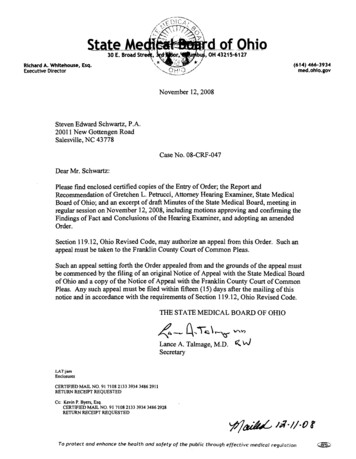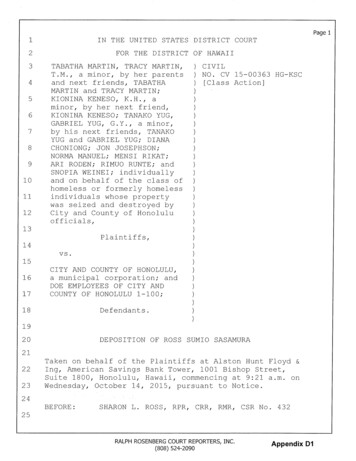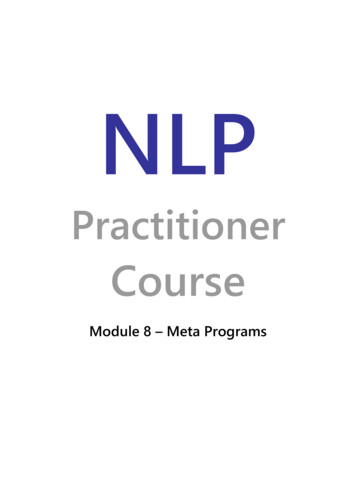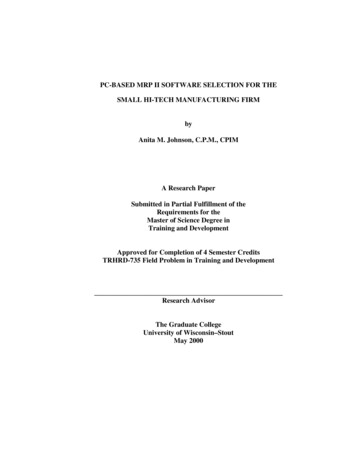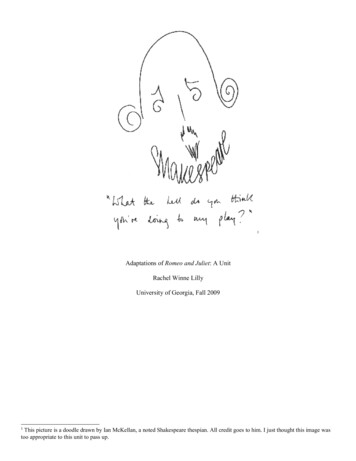
Transcription
SEEING AMERICA: Lilly Martin Spencer’s Peeling Onions, ca. 1852Peeling Onions presents a sympathetic view of mid–nineteenth-centurydomestic life in America by an artist who knew that world intimately.Lilly Martin Spencer (1822 – 1902)Peeling Onions, ca. 1852Oil on canvasGift of the Women’s Council in celebration of the 75th anniversary ofthe Memorial Art Gallery, 88.6Collection of the Memorial Art Gallery of the University of RochesterThe ArtPeeling Onions presents a single figure dramatically highlighted against a darkbackground. Her left hand grasps the offending onion, while a still life offruits, vegetables, and chicken awaits herattention. A closer look reveals the spotson the apples, crumbs on the table, a cooking pan and bottle. One object in particulardraws the viewer into the woman’s space—a stirring spoon that appears to hang off theedge of the table. The realistic objects reflect the artist’s attention to the details ofeveryday life.Glossarystill life: Painting that depicts inanimate objectsthat are typically arranged in a certain formationby the artist.Who is this woman? She is looking outat the viewer but seems lost in her ownthoughts. Her blue dress with its sewingpins on the shoulder suggests other household roles along with her kitchen tasks. Hermuscular arms and worn reddened handsimply a woman used to hard work, yet hercostume, regal posture, pensive expression,and classical facial features suggest there is more to her character and lifestory. The warm foreground light, the careful modeling of the face and bodyClassroom Guide: Seeing America Through Artists’ Eyes1
as well as the assorted objects, the strong linear contours and the traditionaltriangular composition all reflect Spencer’s formal art training. The centralpresence of the woman is familiar in formal portraits; however, the painterhas added the contextual and narrative details that made her work particularly popular with the public.Lilly Martin Spencer often used her family and her domestic help as modelsin her paintings. In a work with a similar theme, Kiss Me and You’ll Kiss the‘Lasses, also known as Making Preserves, Spencer shows the imagination andvariety of her paintings of everyday life.Lilly Martin Spencer (1822 – 1902)Kiss Me and You’ll Kiss the ‘Lasses, 1856Oil on canvasThe ArtistA. Augustus Healy Fund, 70.26Brooklyn Museum651722 837 846 848 85211 1118Lilly Martin Spencerborn in rural OhioSpencermoves toNew YorkCity6518761802 0719 1911192319281939194219481963199819Spencer diesLilly Martin Spencer was a successful American painter at a time when,though views of domestic life were extremely popular, women artists facedobstacles unknown to male painters. Angelique Martin was the only daughter of French immigrant parents who were not only highly educated, butalso very progressive in their attitudes toward women. They themselvesschooled Lilly and her two brothers in their rural Ohio home. With herparents’ encouragement, Lilly moved to Cincinnati to study art with JamesHenry Beard and to paint; in 1848 she and her new husband, Benjamin Spencer, moved to New York City, a necessary move if she was to study art andto sell her work. Unlike most American artists at that time, Spencer chose toforego a trip to Europe, but instead studied the work of the new Europeanartists at New York’s many galleries. She seems to have learned the most atthe Düsseldorf Gallery where she saw the realism, attention to details, highsurface finish and hard contours espoused by the new German artists. Spencer’s success won her admittance in 1851 into the National Academy ofDesign as “Honorary Member, Professional.”Lilly Martin Spencer was the sole provider for her family; her husband hadabandoned his own pursuits to support her career as business manager andoccasional painter of backgrounds. They realized that their financial successnecessitated both a rapid production of paintings and a specialization inpopular genre scenes rather than the allegorical and literary presentationsSpencer had been painting. She struggled to balance her role as artist withthose of breadwinner, housewife, and mother of thirteen children, seven ofwhom lived to adulthood. She had to produce paintings quickly to keep herfamily out of poverty, and, since societal norms and maternal duties kept herin the home, she found her subjects close at hand. She ultimately came toClassroom Guide: Seeing America Through Artists’ EyesLily Martin SpencerThe War Spirit at Home, 1866Oil on canvasPurchase 1944 Wallace M. Scudder Bequest FundCollection of the Newark Museum 44.177Glossarygenre scenes: Depiction of people and everydayactivities.National Academy of Design: Founded in1825, as a professional organization of artists, itsannual exhibition in the 19th century was thepremier venue for American artists to show theirwork.2
specialize in domestic genre scenes, often depicting women in the midst ofdomestic duties. Later in life, as genre scenes declined in popularity, Spencerturned to still lifes and portraiture. She is today acknowledged as one ofAmerica’s premier genre painters.AmericaFemale textile workers inMassachusetts form the LowellFemale Labor Reform Associationand demand a 10-hour workday37Mount Holyoke Collegefounded inMassachusetts44 848 8501 118First women’s rightsOberlin College becomes convention in the U. S. isthe first coeducationalheld in Seneca Falls, NYcollege in the U. S.19th Amendmentallowing women theright to vote is adoptedWoman Suffrage Amendmentis introduced in the U. S.CongressAmelia Bloomerlaunches the dressreform movement18Alice Paul and Lucy Burns organizethe Congressional Union (later knownas the National Woman’s Party)15th Amendment grantingAfrican American men the rightto vote is adopted9166 870 874 878111Elizabeth Cady Stanton and SusanB. Anthony form the AmericanEqual Rights Association12 1319 191818Ida B. Wells launches hernationwide anti-lynchingcampaignWoman’s Christian TemperanceUnion (WCTU) is foundedTheodore Roosevelt’sProgressive Partybecomes the firstnational political partyto adopt a womansuffrage plank20 923119National Woman’sParty proposes the EqualRights Amendment toeliminate discriminationon the basis of gender. Ithas never been adoptedAmerican art reflected society’s interest in the domestic scene. Story-tellinggenre pictures were quite popular until the end of the nineteenth century.New patrons of the arts—the growing middle class—wanted scenes theycould identify with; particularly popular were carefully rendered views ofdomesticity and the familiar physical world.The idea of a “woman’s sphere,” a specific set of gender roles that limitedwomen to the home and private life, was a staple of mid-nineteenth-centurythought. The public arena and workplace were designated for men. Undergirding this social structure, a cult of domesticity glorified the traditionalrole of the American homemaker. As the keepers of society’s conscienceand morality, it was women’s responsibility to teach the young to be goodand productive citizens. Thus, women played a essential role in America’sdemocracy, and artists portrayed them as capable and self-assured people.But if a woman was proficient in the arts herself, it was seen as a genteelaccomplishment; she was not expected to make a serious commitment to itor to any profession.The Woman’s SphereGodey’s Lady’s Book, March 1850University of Rochester Rare Books andSpecial CollectionsIn reality, in 1850, 10 percent of women did work outside the home, usuallyin teaching, nursing, domestic service (as in Peeling Onions), and low-payingfactory jobs. These were primarily unmarried women; once married, womenwere expected to stay at home, and their husbands assumed ownership oftheir wives’ property. But changes in women’s and family life were coming.Although higher learning for women was not widespread, Ohio’s OberlinCollege permitted women to enroll with men in 1837 and in the same yearthe first women’s college, Mt. Holyoke, opened in Massachusetts.After the Civil War, rapid urbanization and industrialization in the UnitedStates hastened societal change. Jobs as stenographers, telephone switchboard operators, and assembly-line workers attracted women out of thehome despite societal pressure to stay out of the public realm. Love matchesbegan to replace arranged marriages, less time was spent in bearing andClassroom Guide: Seeing America Through Artists’ EyesUnknown photographerMount Holyoke Students, circa 1890The National Women’s History Museum3
raising children as urban families grew smaller than traditional families, andwomen sought opportunities in social clubs, reform organizations, and otherareas of the public arena. And women’s full equality in the country’s publicand professional life would become one of the twentieth century’s mostimportant movements.See also Elizabeth L. O’Leary, “Lilly Martin Spencer: Peeling Onions (ca. 1852),” in Marjorie B.Searl, ed., Seeing America: Painting and Sculpture from the Collection of the Memorial Art Gallery of theUniversity of Rochester (Rochester, NY: University of Rochester Press, 2006), 55–57.Classroom Guide: Seeing America Through Artists’ Eyes4
Classroom Activities: Seeing America Through Artists’ EyesObserving DetailWhat clues in the painting tell you when and where this is?How has Spencer created the illusion of a real place?How does knowing the title, Peeling Onions, shape the meaning in this painting?What questions would you ask the artist?Comparing and ContrastingLilly Martin Spencer often used her family and her domestic help as models in her paintings. In a painting with a similar theme,Kiss Me and You’ll Kiss the ‘Lasses, or Making Preserves, Spencer shows the imagination and variety of her paintings of everydaylife. Compare two paintings both completed in the 1850s. What important similarities and differences do you find? Considerthe subject, the figures, the composition and the setting. How has the artist used composition, color and line, light and shadow,pose, gesture and facial expression to tell the viewer about the subject? Describe the life of the American woman as seen inthese two works.Lilly Martin Spencer (1822 – 1902)Lilly Martin Spencer (1822 – 1902)Peeling Onions, ca. 1852Kiss Me and You’ll Kiss the ‘Lasses, 1856Oil on canvasOil on canvasGift of the Women’s Council in celebration of the 75th anniversaryA. Augustus Healy Fund, 70.26of the Memorial Art Gallery, 88.6Brooklyn MuseumCollection of the Memorial Art Gallery of theUniversity of RochesterClassroom Guide: Seeing America Through Artists’ Eyes5
Exploring the Context/Drawing ConclusionsThese six portraits of American women reveal a century of great change in the lives of American women.Why did people havetheir portraits painted? What do the poses, expressions, clothing, setting and other objects reveal?Lilly Martin Spencer (1822 – 1902)Kathleen McEnery Cunningham (1885 – 1971)John Singer Sargent (1856 – 1925)Peeling Onions, ca. 1852Woman in an Ermine Collar, 1909Mrs.William Shakespeare, circa 1896Oil on canvasOil on canvasOil on canvasGift of the Women’s Council in celebration of theGift of Joan Cunningham Williams, PeterMarion Stratton Gould Fund, 57.1475th anniversary of the Memorial Art Gallery, 88.6Cunningham, and Michael McEneryCollection of the Memorial Art Gallery of theCollection of the Memorial Art Gallery of theCunningham, 83.13University of RochesterUniversity of RochesterCollection of the Memorial Art Gallery of theUniversity of RochesterAmmi Phillips (1788 – 1865)Gilbert Stuart (1757 – 1828)Mary Abastenia St. Leger Eberle (1878 – 1942)Old Woman with a Bible, ca. 1834Elizabeth Perkins Sturgis (1756 – 1843), ca. 1806Windy Doorstep, 1910Oil on linenOil on canvasBronzeBeatrice M. Padelford Trust, 84.22Purchased through the R. T. Miller, Jr. Fund, 41.35Maurice R. and Maxine B. Forman Fund, 2004.14Collection of the Memorial Art Gallery of theCollection of the Memorial Art Gallery of theCollection of the Memorial Art Gallery of theUniversity of RochesterUniversity of RochesterUniversity of RochesterClassroom Guide: Seeing America Through Artists’ Eyes6
Finding and Analyzing Point of ViewImages of the lives of Americans were very popular in the mid-nineteenth century. Whose stories are told in these pictures?What picture of America emerges from these works?DeWitt Clinton Boutelle (1820 – 1884)George Catlin (1796 – 1872)The Indian Hunter, 1846Shooting Flamingoes, 1857Oil on canvasOil on canvasMarion Stratton Gould Fund, 84.47R. T. Miller Fund, 1941, transferred to Marion Stratton Gould Fund, 1949, 41.25Collection of the Memorial Art Gallery of the University of RochesterCollection of the Memorial Art Gallery of the University of RochesterMortimer Smith (1840 – 1896)Unknown, AmericanLilly Martin Spencer (1822 – 1902)Home Late, 1866American Harvesting, after a painting by Jasper Cropsey,Peeling Onions, ca. 1852Oil on canvasafter 1851Oil on canvasMarion Stratton Gould Fund, 75.139Oil on canvasGift of the Women’s Council inCollection of the Memorial Art Gallery of theAnonymous gift, 77.196celebration of the 75th anniversary ofUniversity of RochesterCollection of the Memorial Art Gallery of thethe Memorial Art Gallery, 88.6University of RochesterCollection of the Memorial ArtGallery of theUniversity of RochesterClassroom Guide: Seeing America Through Artists’ Eyes7
Exploring the Context/Finding and Analyzing Point of ViewCompare the portrayal of the woman in Peeling Onions with pictures of women in domestic roles today. What are they doing?What objects are used to tell their stories?Exploring the ContextArtists are keen observers and commentators on the world in which they live. Use The Artist and America timelines to consider the effect of American history and art history as reflected in their artwork. In what ways did the artist capture or reflectthe events, mood and/or values of his/her America? In what ways did the artist continue or alter the American art traditionshe/she would have seen?We are grateful for the generous support of this project from the Anne and Vincent DeClue family and our SchoolProgram sponsors: Dominion, Bank of America, the Mary W. Clark Trust and two anonymous donors. Additional support is provided by Thomson Reuters, the Chester and Dorris Carlson Charitable Trust, Mr. and Mrs. Thomas F. Judson Jr.,Rochester Gas and Electric Corporation, Hammer Packaging, the estate of Estelle B. Goldman and an anonymous donorfor the McPherson Director of Education.Classroom Guide: Seeing America Through Artists’ Eyes8
Oil on canvas Purchase 1944 Wallace M. Scudder Bequest Fund Collection of the Newark Museum 44.177 Lilly Martin Spencer (1822 - 1902) Kiss Me and You'll Kiss the 'Lasses, 1856 Oil on canvas A. Augustus Healy Fund, 70.26 Brooklyn Museum Classroom Guide: Seeing America Through Artists' Eyes 1822 1902 Lilly Martin Spencer born in rural Ohio



